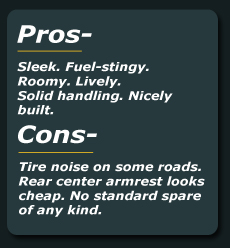2011 Hyundai Elantra
Hyundai’s
redesigned compact 2011 Elantra has high fuel economy and large-car
features.
Prices: $14,830-$21,980
LA JOLLA, Calif.—Why not get subcompact car fuel economy with
a slick compact auto that’s so roomy the EPA classifies as a
mid-size car and that even offers heated rear seats?
Why not, indeed? That’s the question Hyundai asked itself and
came up with its new sleekly styled 2011 Elantra sedan, which does all
that…and then some.
Hyundai is especially proud of the fact that the EPA says all versions
of the Elantra get an estimated 40 miles per gallon on the highway,
with either a new six-speed manual gearbox or new six-speed automatic
transmission. Estimated city economy for all versions is 29 mpg.
“We don’t charge extra for any Elantra version with
a 40-mpg rating,” quipped a Hyundai executive at a media
introduction of the car near San Diego, Calif. He was referring to the
fact that some rivals with conventional engines only reach that figure
with a special “economy” model.
Hyundai has been around a long time here, but some Americans still
think the South Korean outfit is a Japanese automaker. The 2011
front-wheel-drive Elantra was designed at the automaker’s
North American Design Center in Irvine, Calif., and is built at
Hyundai’s Alabama plant.
The nicely built Elantra’s low front end goes with its highly
aerodynamic styling, but can be damaged if it hits rather high parking
stops at, say, a 7-Eleven. It rides on a 106.3-inch
wheelbase, or two inches longer than that of the previous Elantra, and
overall length is up by about an inch to 178.3 inches. Width remains
the same, but height is lowered by 1.8 inches to 56.5 inches, without
affecting headroom.
The new Elantra has scads of interior room, although the center of the
rear seat is too firm for anything but short trips. The relatively long
wheelbase allows for compact car efficiency with mid-size car comfort.
Indeed, the EPA classifies the new new Elantra as a mid-size car, not a
compact auto such as the rival Honda Civic and Toyota Corolla.
The Elantra starts at $14,830 for the base, price-leader GLS Standard
model and ends with the $21,980 Premium version. Media at the preview
got the $19,980 Limited model, which fits just below the Premium, to
drive several hundred miles over a variety of roads.
The new Elantra is pretty well-equipped and even offers optional heated
front and rear seats—a segment first. There are no
stand-alone options, except for a mini-spare tire. One thus must turn
to option packages for extras such as the heated seats, leather
upholstery, power sunroof, proximity key with push-button engine start,
navigation system, rearview camera, premium audio system and hands-free
phone system with voice
recognition.
The Elantra has a double-overhead-camshaft, 16-valve 1.8-liter
four-cylinder engine. It kicks out 148 horsepower at a lofty
6,500 rpm and is a light, smooth free-revving unit with nifty features
such as dual continuously variable valve timing and a plastic two-stage
Variable Intake System that allows switching between long and short
intake manifolds—resulting in an across-the-board performance
increase.
There’s also electronic throttle control for improved
driveablity, response and fuel economy. A maintenance-free (always good
news) silent timing chain system enhances durability and helps keep
things quiet.
The engine works efficiently with the manual transmission or automatic,
which has a manual-shift feature. Most Elantra buyers are expected to
get the automatic.
The new Elantra is the first small car in Hyundai’s lineup to
get the responsive six-speed automatic, which was in my test car. No
manual-transmission-model was available for testing at the preview.
The Elantra is no fireball, but provides good merging into freeway
traffic and decent 65-75 mph passing. It has world-class weight
efficiency, at 2,661-2,820 pounds with the manual transmission and
2,701-2,877 pounds with the automatic.
There’s widespread use of high-strength steel, and standard
safety items include electronic stability control, vehicle stability
management with traction control and four-wheel anti-lock disc brakes
with brake assist and electronic brake-force distribution for surer
panic stops.
The brake pedal initially felt a bit light, but I soon got used to
using the pedal to make smooth, short stops. Of course, the
car is loaded with air bags and side curtains.
The electric power steering is quick and adjusts to changing driving
conditions while improving fuel economy. It feels somewhat stiff, but
allows a tight turning circle. Handling is sharp, with the car staying
firmly planted while zipping through tight mountain curves. The ride is
on the firm side, but isn’t uncomfortable.
My test car had wide 45-series tires on 17-inch wheels, which
doubtlessly helped handling. Available are 15-, 16- and 17-inch wheels.
The wider the wheels and tires, the better the handling.
The interior is attractive, although there’s a fair amount of
hard plastic in the dashboard area. Backlit gauges don’t get
washed out by bright sunlight, as they do on many cars, and controls
are fairly easy to use. Front seats are supportive, and there are
plenty of decent-sized cabin storage areas. The rear
fold-down center armrest, however, looks cheap and sits at an angle
when flipped forward.
The roomy trunk has a low, wide opening, and split rear seatbacks with
trunk releases for security’s sake fold flat to enlarge the
cargo area.
The new Elantra seems certain to be another hit for Hyundai, which was
one of few automakers to register higher sales in the dreadful vehicle
sales market of 2009.









<






